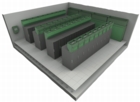A fresh angle on data centres

Does meeting the cooling requirements of equipment in a data centre using half the air volume supplied at a higher temperature than usual sound like an impossible engineering solution — or very elegant?
About half the air that is supplied to a data centre to be drawn through the cabinets of equipment to remove heat from the blade servers in them never sees the inside of a cabinet. The rest simply passes through the space and picks up a little bit of heat before it enters the extract system, where it joins air that has been drawn through the cabinets and expelled into the hot aisle between the rear of two rows of cabinets.
To Tom Absalom, director of JCA Group, a turnkey solution provider for cooling systems for data centres, it seemed there had to be a more effective and energy-efficient approach to cooling. His vision was for all the air supplied to a data hall to be drawn through the cabinets and then return to the CRAC units through the false-ceiling void. The volume of air extracted would be monitored and exactly matched by the air supplied by the CRAC units
Two immediate benefits are apparent.
First, the volume of air supplied to the data hall is halved — with obvious savings in energy consumption by the fans.
Second, the return temperature would be much higher than if only half the air passes through the cabinets, making the process of cooling the return air to be put back into the data hall more efficient because of the greater temperature difference between it and the cooling coil.
Other benefits will become apparent later.
Since his company did not have the resources to develop the concept into a working solution, Tom Absalom approached Airedale as a major manufacturer of air-conditioning systems and with the support of a substantial research-and-development centre..
It took about three years to move from concept to a system that could, and has, been applied to a data centre Illumina at Cambridge where a PUE (power usage effectiveness) of 1.2 has been achieved.
The key to the concept is how the air off the cabinets is handled. Instead of being pushed into the hot aisle by the fans in the blade servers. The air is discharged from the top of the rack and transferred into the ceiling void by an active cabinet exhaust unit (ACE). There are two variable-speed fans in the ACE unit; they run together to maintain a slight negative pressure in the rear of the cabinet that is sufficient to ensure adequate, but not excessive, airflow. That means there is no need for a hot aisle. One fan would be adequate to maintain the negative pressure, so there is N+1 redundancy. If both fans should fail or the power supply to them fails, an ‘incident panel’ on the unit will open to vent exhaust air to the hall itself – so the ACE unit is not a point of failure.
Each cabinet has its own ACE unit, so only the required volume of air is draw through each cabinet according to its heat load — up to 20 kW.

Pressure and temperature sensors in each ACE provide operating information that is fed back to the CRAC unit so that the volume of air supplied to the hall matches that being exhausted through the ACE units.
For the concept to work, the cabinets have some special design features, but they can be readily replicated by cabinet manufacturers. The first feature is that air flows through the cabinet from the front to the rear part of the top panel — not out the back. The cabinets are also insulated to reduce heat gain into the hall.
JCA holds the patent on the concept, and Airedale has combined it with its own energy-efficient products to form the Echo system.
The Echo free-cooling chillers, for example, have special heat exchangers so that for much of the year total or partial free cooling can be used to eliminate or reduce the amount of mechanical cooling required.
Another key component is the Echo cooling unit, which is served by chilled water and has variable-speed EC fans so that the air supply can be controlled.
The final, and vital, component is the Echo monitoring and control system.
Reducing the volume of air being moved is just one contributor to the energy efficiency of the Echo system. Tom Absalom suggests that air can be supplied to the data hall at 18°C and 55% RH and be returned to the ceiling void at 36°C 19% RH. Those return conditions would not be acceptable with a hot aisle because people need to work in it. With the Echo approach, the temperature at the rear of a cabinet is the same as the rest of the hall.
Chilled water can be supplied to the CRAC units at a higher temperature than for other systems, making possible more use of free cooling — full free cooling for 50% of the year in London according to Airedale and partial free cooling for 95% of the year.
And for engineers who believe that benefits come with a price, an Echo system is said to have a lower capital cost than conventional systems.








